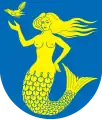Lahti
Lahti (Finnish pronunciation: [ˈlɑhti]; Swedish: Lahtis) is a city and municipality in Finland. It is the capital of the region of Päijänne Tavastia (Päijät-Häme) and its growing region is one of the main economic hubs of Finland. Lahti is situated on a bay at the southern end of lake Vesijärvi about 100 kilometres (60 mi) north-east of the capital city Helsinki and 74 kilometres (46 mi) east of Hämeenlinna, the capital of the region of Tavastia Proper (Kanta-Häme). It is also situated at the intersection of Highway 4 (between Helsinki and Jyväskylä) and Highway 12 (between Tampere and Kouvola), which are the most significant main roads of Lahti.
Lahti
Lahtis | |
|---|---|
City | |
| Lahden kaupunki Lahtis stad | |
 Center of the city | |
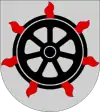 Coat of arms | |
| Nickname(s): Chicago of Finland, Business City | |
 Location of Lahti in Finland | |
| Coordinates: 60°59′N 025°39′E | |
| Country | |
| Region | |
| Sub-region | Lahti sub-region |
| Charter | 1905-11-01 |
| Government | |
| • City manager | Pekka Timonen |
| Area (2018-01-01)[1] | |
| • Total | 517.63 km2 (199.86 sq mi) |
| • Land | 459.47 km2 (177.40 sq mi) |
| • Water | 19.53 km2 (7.54 sq mi) |
| Area rank | 191st largest in Finland |
| Population (2020-07-31)[2] | |
| • Total | 119,944 |
| • Rank | 8th largest in Finland |
| • Density | 261.05/km2 (676.1/sq mi) |
| Population by native language | |
| • Finnish | 95.7% (official) |
| • Swedish | 0.3% |
| • Others | 4% |
| Population by age | |
| • 0 to 14 | 14.7% |
| • 15 to 64 | 67.2% |
| • 65 or older | 18.1% |
| Time zone | UTC+02:00 (EET) |
| • Summer (DST) | UTC+03:00 (EEST) |
| Municipal tax rate[5] | 19.5% |
| Website | www.lahti.fi |
In English, the Finnish word Lahti literally means bay. Lahti is also dubbed the "Chicago of Finland" due to the premise of both cities, when they were known as "slaughterhouse cities".[6][7][8] Also, the troubled history of both cities in the field of crime has been seen as one of the similarities.[6][7][8] The European Commission has named Lahti as the European Green Capital of 2021.[9][10]
The coat of arms of the city depicts a train wheel surrounded by flames.
History
Lahti was first mentioned in documents in 1445. The village belonged to the parish of Hollola and was located at the medieval trade route of Ylinen Viipurintie, which linked the towns of Hämeenlinna and Viipuri.


The completion of the Riihimäki – St. Petersburg railway line in 1870 and the Vesijärvi canal in 1871 turned Lahti into a lively station, and industrial installations began to spring up around it. For a long time, the railway station at Vesijärvi Harbour was the second busiest station in Finland. Craftsmen, merchants, a few civil servants and a lot of industrial workers soon mixed in with the existing agricultural peasantry.
On 19 June 1877, almost the entire village was burned to the ground. However, the accident proved to be a stroke of luck for the development of the place, as it led to the authorities resuming their deliberations about establishing a town in Lahti. The village was granted market town rights in 1878 and an empire-style, grid town plan was approved, which included a large market square and wide boulevards. This grid plan still forms the basis of the city center. Most of the buildings were low wooden houses bordering the streets.
Lahti was founded during a period of severe economic recession. The Russian Empire was encumbered by the war against Turkey. The recession also slowed down the building of the township: land would not sell and often plots were not built on for some time. In its early years, the town with its meagre 200 inhabitants was too small to provide any kind of foundation for trade. At the end of the 1890s, Lahti's Township Board increased its efforts to enable Lahti to be turned into a city. In spring 1904, the efforts finally bore fruit as the Senate approved of the application, although it was another eighteen months before Tsar Nicholas II finally gave his blessing and issued an ordinance for establishing the city of Lahti.
At the end of 1905, the area that now comprises Lahti accommodated around 8,200 people of whom just under 3,000 lived in the city itself. All essential municipal institutions were built in just ten years, including a hospital and a city hall. At the same time, a rapid increase in brick houses was taking place in the centre of the city. The Battle of Lahti was fought in the 1918 Finnish Civil War as the German Detachment Brandenstein took the town from the Reds.
In the early 1920s the city gained possession of the grounds of the Lahti Manor, an important piece of land previously blocking the city from the lake. Large-scale industrial operations grew rapidly in the 1930s as did the population; Lahti, at the time, was one of Finland's fastest-growing cities, and before the start of the Winter War its population was approaching 30,000.

Through the addition of new areas in 1924, 1933 and 1956, Lahti grew, both in terms of population and surface area. Especially strong was the growth after the wars, when Lahti accepted about 10,000 immigrants from Karelia, after the region was surrendered to the Soviet Union, and then later in the 1960 and 1970s as a result of mass urbanization. The rapid population growth came to a sharp end in 1975 and the city has since grown clearly slower albeit mostly steadily, with the latest notable growth in population happening in 2016 when the municipality of Nastola became a part of Lahti.
In December 2018 Lahti became the first new university city in Finland after Rovaniemi in 1979 when the Parliament accepted a change in the university law. LUT University nowadays consists of two campuses, Lappeenranta and Lahti.
Geography
The Salpausselkä ridge with its hills as well as countless lakes are representative views of the city. The biggest lake is Vesijärvi which also is a gateway to the Central Finland via Lake Päijänne. There is also pond called Pikku-Vesijärvi ("Little Vesijärvi") near the Lanu-puisto park.[11]
Subdivisions
The area of the city of Lahti is divided in two ways: first, the 40 individually numbered districts (Finnish: kaupunginosa),[12] and second, the 9 greater areas (Finnish: suuralue), which are divided into 41 statistical districts (Finnish: tilastollinen kaupunginosa) and further into 169 statistical areas (Finnish: tilastoalue).[13] The definitions of the districts and statistical districts do not necessarily match each other. Below are listed the districts:
- Keski-Lahti
- Kartano
- Paavola
- Niemi
- Kiveriö
- Kivimaa
- Mukkula
- Kilpiäinen
- Pesäkallio
- Kytölä
- Viuha
- Kunnas
- Ahtiala
- Koiskala
- Myllypohja
- Möysä
- Järvenpää
- Kolava
- Kujala
- Kerinkallio
- Ämmälä
- Renkomäki
- Nikkilä
- Laune
- Asemantausta
- Sopenkorpi
- Hennala
- Jokimaa
- Okeroinen
- Kärpänen
- Pirttiharju
- Salpausselkä
- Jalkaranta
- Villähde
- Nastola
- Uusikylä
- Seesta
- Ruuhijärvi
- Immilä
- Pyhäntaka
Climate
Under the Köppen climate classification, Lahti is right on the boundary between being a humid continental climate (Dfb) and a subarctic climate (Dfc). Summers are generally mild to warm, while winters are cold and snowy.
| Climate data for Lahti Laune (1981–2010 normals, extremes 1938- present) | |||||||||||||
|---|---|---|---|---|---|---|---|---|---|---|---|---|---|
| Month | Jan | Feb | Mar | Apr | May | Jun | Jul | Aug | Sep | Oct | Nov | Dec | Year |
| Record high °C (°F) | 7.5 (45.5) |
9.6 (49.3) |
16.6 (61.9) |
24.5 (76.1) |
30.1 (86.2) |
32.1 (89.8) |
35.0 (95.0) |
33.8 (92.8) |
27.6 (81.7) |
18.8 (65.8) |
13.2 (55.8) |
10.4 (50.7) |
35.0 (95.0) |
| Average high °C (°F) | −3.5 (25.7) |
−3.5 (25.7) |
1.6 (34.9) |
8.6 (47.5) |
16.0 (60.8) |
19.9 (67.8) |
22.7 (72.9) |
20.4 (68.7) |
14.4 (57.9) |
7.8 (46.0) |
1.6 (34.9) |
−1.9 (28.6) |
8.7 (47.6) |
| Daily mean °C (°F) | −6.4 (20.5) |
−7.0 (19.4) |
−2.7 (27.1) |
3.5 (38.3) |
10.1 (50.2) |
14.4 (57.9) |
17.2 (63.0) |
15.1 (59.2) |
9.7 (49.5) |
4.6 (40.3) |
−0.6 (30.9) |
−4.5 (23.9) |
4.4 (40.0) |
| Average low °C (°F) | −9.8 (14.4) |
−10.9 (12.4) |
−6.9 (19.6) |
−1.5 (29.3) |
3.7 (38.7) |
8.4 (47.1) |
11.3 (52.3) |
9.9 (49.8) |
5.4 (41.7) |
1.4 (34.5) |
−3.1 (26.4) |
−7.6 (18.3) |
0.0 (32.0) |
| Record low °C (°F) | −40.6 (−41.1) |
−35.6 (−32.1) |
−31.4 (−24.5) |
−19.3 (−2.7) |
−7.0 (19.4) |
−2.6 (27.3) |
1.5 (34.7) |
−2.0 (28.4) |
−8.4 (16.9) |
−16.5 (2.3) |
−23.8 (−10.8) |
−33.1 (−27.6) |
−40.6 (−41.1) |
| Average precipitation mm (inches) | 48.2 (1.90) |
34.3 (1.35) |
35.1 (1.38) |
28.1 (1.11) |
42.6 (1.68) |
64.5 (2.54) |
77.2 (3.04) |
75.3 (2.96) |
58.4 (2.30) |
65.5 (2.58) |
58.4 (2.30) |
50.1 (1.97) |
637.7 (25.11) |
| Average precipitation days | 12.0 | 8.8 | 8.6 | 6.6 | 7.8 | 9.4 | 10.1 | 10.4 | 9.8 | 11.2 | 11.4 | 11.7 | 117.8 |
| Source 1: FMI climatological normals for Finland 1981-2010[14] | |||||||||||||
| Source 2: record highs and lows 1961- present[15] | |||||||||||||
Culture

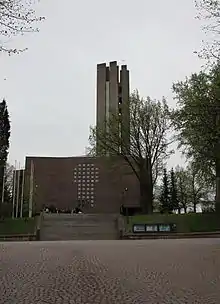
Lahti harbors cultural ambitions, manifested notably in the construction of a large congress and concert centre, the Sibelius Hall (2000) by architects Kimmo Lintula and Hannu Tikka. Lahti has one of Finland's most widely known symphony orchestras, the Lahti Symphony Orchestra (Sinfonia Lahti ), based at the Sibelius Hall, which performs both classical and popular music, notably concentrating on music by Jean Sibelius. The orchestra has won several well respected international prizes.
Lahti's annual music festival programme includes such events as Lahti Organ Festival, a jazz festival held in the city's market square and the Sibelius Festival.
In addition to the Sibelius Hall, other additional notable works of architecture in Lahti are the City Hall (1911) by Eliel Saarinen, the Church of the Cross (1978) by Alvar Aalto, Nastola Church (1804), the oldest church in the city, Joutjärvi church, the City Theatre (1983) by Pekka Salminen, the City Library (1990) by Arto Sipinen, the Piano Pavilion (2008) by Gert Wingårdh, and the Travel Centre (2016) by JKMM Architects. The City of Lahti has also acted as the host city for the international Spirit of Wood Architecture Award, established in Finland in 1999. Some of the prize-winners have received commissions to design small structures in the city; these include small works by Japanese architect Kengo Kuma and Australian architect Richard Leplastrier.
Museums and galleries
- Lahti Ski Museum[17]
- Historical Museum of Lahti[18]
- Lahti Art Museum[19]
- Poster museum[20]
- Radio and TV Museum[21]
- Finland’s motorcycle museum[22]
- The Museum of Military Medicine[23]
- Taarasti Art Center
Sports
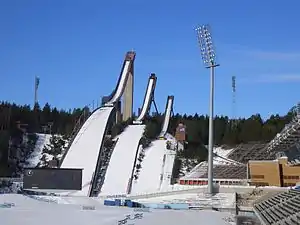

Winter sports
Lahti has a rich sporting tradition, especially in various wintersports. The city is well known for the annually held Lahti Ski Games (Salpausselän kisat) and the Finlandia-hiihto cross-country skiing contest. It is also the only city to host the FIS Nordic World Ski Championships seven times, doing so in 1926, 1938, 1958, 1978, 1989, 2001 and 2017.
Ice hockey
The Pelicans have competed in the top level of Finnish ice hockey, the Liiga, since 1999. Before the new millennium Reipas represented Lahti in top-flight hockey for 50 years. Many former NHL players, such as Janne Laukkanen, Toni Lydman and Pasi Nurminen, have started their careers in Reipas.
Association football
Historically the city's most successful association football club has been Kuusysi. In their golden years lasting from the early 1980s to the 1990s they won five Finnish championships as well as two Finnish Cup titles, with appearances in European competitions each year. Their greatest rivals, Reipas, won a total of three championships and seven cup titles from 1963 to 1978 but diminished in the early 1980s as Kuusysi got stronger.
In the 1990s both clubs ended up in such massive financial difficulties that a merger was executed in 1996, with the newly formed club adopting a new name, crest and colours. FC Lahti has played in the Veikkausliiga since 1999, excluding a season-long visit to the first division in 2011, having placed twice third and appearing in Europe three times.
Other events
The 1997 World Games and the 2009 World Masters Athletics Championships were held in Lahti. For the 1952 Summer Olympics, some of the football matches were played at Kisapuisto.
Education

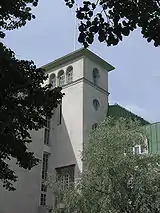
Comprehensive and private education
Lahti has 16 comprehensive schools and eight secondary schools. Comprehensive education is also available in English and Swedish.[24] Lahden yhteiskoulu is the city's only private school offering both comprehensive and upper secondary education.
Upper secondary and vocational education
All four upper secondary schools in Lahti have a specialty: the Lyceum has expertise on subjects such as mathematics and biology, and sports (formerly in Salpauselkä), Tiirismaa focuses on music in association with the Lahti Conservatory, Kannas organises theatre classes and Lahden yhteiskoulu offers an economy-centered class.
Salpaus is an educational consortium owned by the municipalities in Päijänne Tavastia arranging most of the region's vocational education and trade schooling. The privately owned Dila and Lahti Conservatory educate students for healthcare and music-related professions, respectively.
Higher education and LUT University
Lahti's greatest educational assets are the Lappeenranta-Lahti University of Technology LUT as well as also highly valued Institute of Design and Fine Arts, which is a part of LAB University of Applied Sciences.
LUT University offers education in engineering science as well as in business and management. The Institute of Design and Fine Arts has gained international recognition in particular for jewelry and industrial design, while other areas of expertise include metal, woodworking and furniture.
There are two national sports institutes in greater Lahti. The Vierumäki International Sports Institute based in Heinola is the most versatile centre of sports and physical education in the country, operating under the Ministry of Culture and Education. In addition the Pajulahti Sports Institute, located in the district of Nastola in Lahti, is one of the leading sports and training centres in Finland.
Furthermore one of Finland's six multidisciplinary university campuses is based in Lahti. The University of Helsinki's Department of Environmental Sciences is the university's sole science department located outside the Greater Helsinki area.

Economy
The economic region of Lahti, which includes the surrounding municipalities, was strongly affected by the collapse of Finnish-Soviet trade and by the recession in the early 1990s. The value of production slumped, especially in the mechanical engineering industry and other manufacturing industries (e.g. the furniture industry). Production also decreased in the textile and clothing industry. In 1990, there were 90,370 jobs in the Lahti region. The number of jobs diminished over the next couple of years, so that in 1993 there were fewer than 70,000 jobs in the region. The number of jobs had slowly increased to 79,138 in 1999.

| Employment by sector (City of Lahti) | 1980 | 1990 | 2000 | 2007 |
|---|---|---|---|---|
| Services | 52.0% | 59.3% | 63.5% | 72.4% |
| Industry | 47.1% | 40.1% | 36.4% | 27.4% |
| Agriculture & Forestry | 0.9% | 0.6% | 0.1% | 0.2% |
In 1995, R&D expenditure was FIM 715 per person, while Finland's average was about FIM 2050. The amount of Tekes (the National Technology Agency) funding in the Lahti Region grew 40% during 2004–2007 while the average growth in Finland was 60%.

| Gross domestic product (Lahti Region) | 2000 | 2001 | 2002 | 2003 | 2004 | 2005 | 2006 |
|---|---|---|---|---|---|---|---|
| GDP at current prices; million € | 3,449.3 | 3,709.7 | 3,697.5 | 3,982.3 | 4,136.8 | 4,242.4 | 4,381.9 |
| Changes of GDP; year 2000 = 100% | 100.0% | 107.5% | 107.2% | 115.5% | 119.9% | 123.0% | 127.7% |
| GDP per capita; whole country =100% | 80.7% | 82.0% | 79.4% | 84.3% | 83.9% | 83.4% | 81.2% |
| GDP per employed; whole country =100% | 86.6% | 87.3% | 83.6% | 88.9% | 88.7% | 88.6% | 87.1% |
Demographics
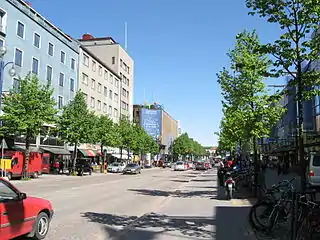
As of 30 June 2019 the population of Lahti was 120,078 making it the eighth largest city in Finland by population. The population of Nastola, which became a part of Lahti on 1 January 2016, has not been noticed in the following chart.
| Population by district | 1964 | 1970 | 1980 | 1990 | 2000 | 2007 |
|---|---|---|---|---|---|---|
| Centre (Keskusta) | 27,400 | 21,800 | 15,600 | 13,700 | 17,280 | 19,778 |
| Laune | 13,200 | 17,100 | 23,300 | 22,600 | 23,670 | 24,568 |
| Kivimaa–Kiveriö–Joutjärvi | 17,100 | 23,500 | 20,700 | 18,300 | 17,790 | 16,974 |
| Kärpänen | 9,400 | 7,600 | 12,800 | 12,700 | 11,940 | 11,612 |
| Ahtiala | 4,600 | 5,100 | 5,100 | 9,100 | 10,500 | 10,897 |
| Mukkula | 1,300 | 9,100 | 9,500 | 8,500 | 8,120 | 7,877 |
| Jalkaranta | 2,500 | 1,950 | 5,600 | 6,200 | 6,020 | 5,852 |
| Kolava–Kujala | 900 | 550 | 400 | 300 | 310 | 710 |
Transportation
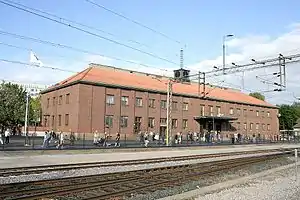
Local transport
The city is served by 20 local bus lines, most of which are pendulum lines between two different areas via city centre. Bus transport in the Päijänne Tavastia region is organised by the regional transportation authority, known as Lahden seudun liikenne or LSL, and run by several private companies which have bid for the right to run their lines. LSL buses cover all urban areas at 10–20 minute intervals and most nearby municipalities at 30–60 minute intervals.
Lahti is served by VR commuter rail, the Z train to Helsinki and the G train to Riihimäki run hourly. Most services to Kouvola don't have a letter designation and are run every three hours aside from rush hours. There are plans for building two new train stops inside the city limits before 2020, Hennala and Karisto. A local service to Heinola has been proposed but renovating the old line has been deemed too expensive and unprofitable in the long term, unless the Finnish state reaches an agreement with regional councils to finance a direct rail link from Lahti to either Jyväskylä or Mikkeli.
Long-distance transport
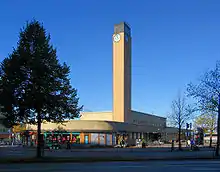
The city's main transportation hubs are the market square (Kauppatori) and the travel centre (Matkakeskus), with local buses providing a non-stop service between the two. The travel centre, which replaced the old Lahti bus station that had been in use since 1939, was built between 2014 and 2016 around the Lahti railway station by building new local bus stops around the station, a long-distance bus terminal next to the station building and an automated parking facility for commuters.
All local and long-distance trains and buses stop at the travel centre, making it convenient to transfer from one mode of transport to another. The city council has sold the old bus station in the city centre and it will be redeveloped for other uses in the near future.
Trivia
The asteroid 1498 Lahti was named after the city by its discoverer, the Finnish astronomer Yrjö Väisälä.
The radio masts on top of the Radiomäki are 150 metres (490 ft) tall.[25]
Lahti won the European Green Capital Award of the year 2021.
Notable people from Lahti
- Göran Enckelman, footballer
- Valtteri Bottas, Formula One Driver
- Pasi Nurminen, former NHL goaltender
- Toni Lydman, former NHL player
- Toni Nieminen, ski jumper
- Janne Ahonen, ski jumper
- Mikko Ilonen, professional golfer
- Jari Litmanen, professional footballer
- Aksu Hanttu, drummer of Entwine
- Ilona Jokinen, soprano opera singer
- Jukka-Pekka Saraste, conductor and violinist
- Eija-Riitta Korhola, politician
- Jaana Pelkonen, politician and hostess of Eurovision Song Contest 2007
- Jimi Tenor, musician
- Alina Voronkova, model and beauty pageant titleholder who won Miss Finland 2018
International relations
Twin towns—sister cities
 Västerås, Sweden (since 1940)
Västerås, Sweden (since 1940)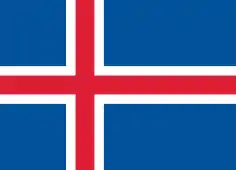 Akureyri, Iceland (since 1947)
Akureyri, Iceland (since 1947) Randers, Denmark (since 1947)
Randers, Denmark (since 1947) Ålesund, Norway (since 1947)
Ålesund, Norway (since 1947)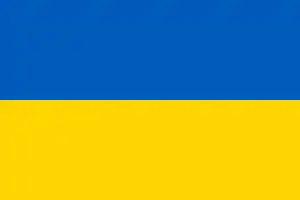 Zaporizhzhya, Ukraine (since 1953)
Zaporizhzhya, Ukraine (since 1953) Pécs, Hungary (since 1956)
Pécs, Hungary (since 1956) Garmisch-Partenkirchen, Germany (since 1987)
Garmisch-Partenkirchen, Germany (since 1987) Suhl, Germany (since 1988)
Suhl, Germany (since 1988) Kaluga, Russia (since 1994)
Kaluga, Russia (since 1994) Narva, Estonia (since 1994, partnership agreement)
Narva, Estonia (since 1994, partnership agreement) Deyang, Sichuan, China (since 2000)
Deyang, Sichuan, China (since 2000) Wuxi, Jiangsu, China (since 2011)
Wuxi, Jiangsu, China (since 2011) Norberg, Sweden
Norberg, Sweden Tamsalu, Estonia
Tamsalu, Estonia
References
- "Area of Finnish Municipalities 1.1.2018" (PDF). National Land Survey of Finland. Retrieved 30 January 2018.
- "Suomen virallinen tilasto (SVT): Väestön ennakkotilasto [verkkojulkaisu]. Heinäkuu 2020" (in Finnish). Statistics Finland. Retrieved 13 September 2020.
- "Population according to language and the number of foreigners and land area km2 by area as of 31 December 2008". Statistics Finland's PX-Web databases. Statistics Finland. Retrieved 29 March 2009.
- "Population according to age and gender by area as of 31 December 2008". Statistics Finland's PX-Web databases. Statistics Finland. Retrieved 28 April 2009.
- "List of municipal and parish tax rates in 2011". Tax Administration of Finland. 29 November 2010. Retrieved 13 March 2011.
- 7 Interesting Facts about Lahti
- Lahti on Suomen Chicago - syystäkin (in Finnish)
- Onko Lahti oikeasti "Suomen Chicago"? Poliisi kertoo (in Finnish)
- Lahti - European Green Capital 2021
- European Green Capital: 2021 - Lahti
- "Lahden pienten jarvien veden laadun tutkimuksia 30 vuotta" (PDF) (in Finnish). Puhdasvesijarvi.fi. Retrieved 2020-12-22.
- "Lahti map service: Quarters of Lahti City". City of Lahti. Retrieved 17 January 2021.
- "Statistics service of the City of Lahti" (in Finnish). Retrieved 17 January 2021.
- "FMI normals 1981-2010" (PDF). fmi.fi. Retrieved 26 April 2016.
- "FMI open data". FMI. Retrieved 26 April 2016.
- "Ski Museum – Snow Fun Year-round". lahdenmuseot.fi. City of Lahti. Retrieved 17 July 2020.
- "Lahti Historical Museum". lahdenmuseot.fi. City of Lahti. Retrieved 17 July 2020.
- "Lahti Art Museum". lahdenmuseot.fi. City of Lahti. Retrieved 17 July 2020.
- "Lahti Poster Museum". lahdenmuseot.fi. City of Lahti. Retrieved 17 July 2020.
- "Radio and TV Museum". lahdenmuseot.fi. City of Lahti. Retrieved 17 July 2020.
- "Finland's Motorcycle Museum". moottoripyoramuseo.fi/. Finland’s Motorcycle Museum. Retrieved 17 July 2020.
- "The Museum of Military Medicine". sotilaslaaketieteenmuseo.fi. The Museum of Military Medicine. Retrieved 17 July 2020.
- "Basic education". Lahti.fi. Retrieved 2020-08-22.
- "Lahti Transmission Towers". Structurae.net. Retrieved 6 December 2020.
- "Lahti-info" (in Finnish). City of Lahti. Retrieved 21 August 2019.
External links
| Wikimedia Commons has media related to Lahti. |
- 1952 Summer Olympics official report. pp. 62–3.
- City of Lahti – Official city website.
- Lahti Guide – information for visitors to Lahti.
- Lahti region - Living, business and travel information.
- Lahti info - News, events, business and other information.
- Lahti video - documentary about city of Lahti
 Lahti travel guide from Wikivoyage
Lahti travel guide from Wikivoyage
Maps
Media
- Etelä-Suomen Sanomat – local newspaper in Finnish (translates as South Finland News)
